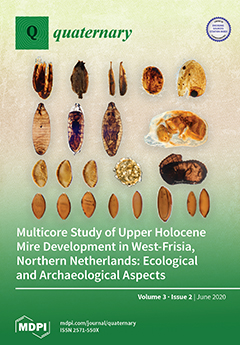Open AccessFeature PaperArticle
Multicore Study of Upper Holocene Mire Development in West-Frisia, Northern Netherlands: Ecological and Archaeological Aspects
by
Bas van Geel, Otto Brinkkemper, Guido B.A. van Reenen, Nathalie N.L. Van der Putten, Jasmijn E. Sybenga, Carla Soonius, Annemieke M. Kooijman, Tom Hakbijl and William D. Gosling
Cited by 11 | Viewed by 7228
Abstract
We studied twelve late Holocene organic deposits in West-Frisia, The Netherlands. Pollen, spores, non-pollen palynomorphs, mosses, other botanical macrofossils and insect remains were recorded for reconstructions of changing environmental conditions. Eastern West-Frisia was a cultivated landscape during the Bronze Age, but it became
[...] Read more.
We studied twelve late Holocene organic deposits in West-Frisia, The Netherlands. Pollen, spores, non-pollen palynomorphs, mosses, other botanical macrofossils and insect remains were recorded for reconstructions of changing environmental conditions. Eastern West-Frisia was a cultivated landscape during the Bronze Age, but it became a freshwater wetland in the Late Bronze Age. In most of our sites, radiocarbon dates show that time transgressive inundation of soils preceded the climate shift at 850 cal BC for several centuries. We suggest that solar forcing of climate change may have delivered the final push to the inundation and depopulation of West-Frisia, which had already commenced several centuries before, due to sealevel rise. We did not find evidence for significant Bronze Age tree growth in West-Frisia before the inundations. Vegetation successions in the new wetlands developed from shallow mineral-rich freshwater to rich-fen vegetation. Subsequently poor fen vegetation with birch and pine developed, and the natural succession led to ombrotrophic raised bog vegetation. Complete successions from shallow, mineral-rich lakes to raised bog lasted between 1000 and 1500 calendar years. We hypothesize that medieval drainage and reclamation became possible only when the mires of West-Frisia had reached the raised bog stage. Reclamation of raised bogs by medieval farmers (drainage, eutrophication, peat digging) caused compaction, oxidation and loss of the upper part of the peat deposit. Seeds of salt-tolerant and salt-demanding plant species indicate that the medieval sites were inundated during storm surges with brackish or salt water, which triggered the farmers to build artificial mounds and, later, dikes. Under mounds and dikes, peat deposits remained protected against further decay. With our data we deliver a long-term perspective on contemporary ecosystem dynamics of freshwater wetlands, relevant for nature conservation and future climate change.
Full article
►▼
Show Figures





